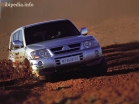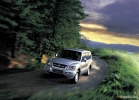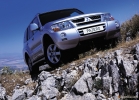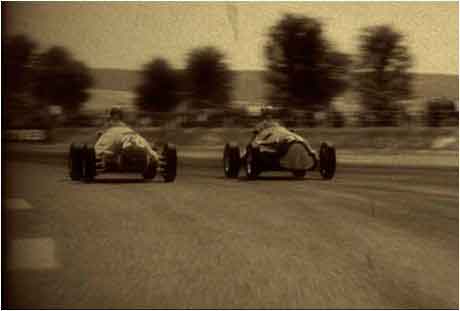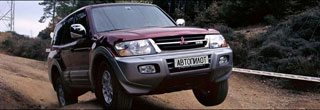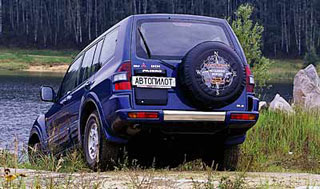Test drive Mitsubishi Pajero (Montero, Shogun) LWB 2000 - 2003 SUV
Matured "Pajero"
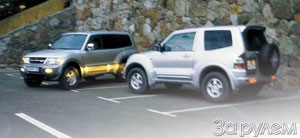 Dear all -terrain vehicles have been popular with very wealthy citizens of Russia for several years. They became a kind of symbol of well -being and, if you want, a certain caste affiliation.
Dear all -terrain vehicles have been popular with very wealthy citizens of Russia for several years. They became a kind of symbol of well -being and, if you want, a certain caste affiliation. As a rule, they are purchased from us in the richest configuration, with an abundance of additional equipment, in order to make it clear who is the owner of such a machine. Pajero is no exception. True, for some time now there has been a decline in demand for this model, which is understandable: the last, and even then its insignificant update was in 1997. And here is the long -awaited Pajero III - first on the Tokyo, and then Detroit and Geneva car dealerships.
The third generation
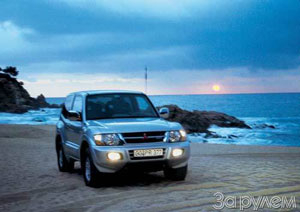 The car has changed, and thoroughly what the magazine has already written about this year (ZR, 2000, No. 2, p. 50). In particular, that new engines appeared. The gamma is headed by a 3.5-liter 24-valve V-shaped gdi six (with direct fuel injection into the cylinders) with a capacity of 202 liters. With. Another novelty is a 3.2-liter D1-D diesel with turbocharged, direct injection and an intermediate cooler.
The car has changed, and thoroughly what the magazine has already written about this year (ZR, 2000, No. 2, p. 50). In particular, that new engines appeared. The gamma is headed by a 3.5-liter 24-valve V-shaped gdi six (with direct fuel injection into the cylinders) with a capacity of 202 liters. With. Another novelty is a 3.2-liter D1-D diesel with turbocharged, direct injection and an intermediate cooler. Recall of other changes. Pajero III has a new body with an integrated frame. This design allows not only to increase the rigidity of bending and twisting, but also to lower the center of mass, which is very significant for an all -terrain vehicle. A new back suspension also deserves attention - independent, multi -link.
We especially note the changes in the transmission: its current version of the 4WD-II Super selector is equipped with electronic serving of the serving of the distribution. The distribution of torque along the axes is in charge of the planetary interdosseous differential: it doses the torque on the front and rear axles in relation to 33:67. And Wyeskyft allows you to automatically change the distribution of the moment between the axes up to 50:50.
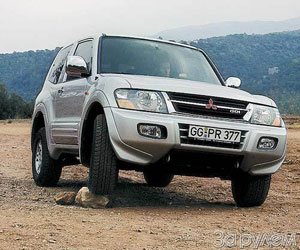 The new Pajero is equipped with an InVeCS II Sports Mode, which makes it possible to switch the transmission and manually, combining the advantages of mechanics and automatic machine. The company’s know -how - a cardan shaft of carbon fiber is formed in serious clashes - so the developers protected the fuel tank and rear passengers from damage.
The new Pajero is equipped with an InVeCS II Sports Mode, which makes it possible to switch the transmission and manually, combining the advantages of mechanics and automatic machine. The company’s know -how - a cardan shaft of carbon fiber is formed in serious clashes - so the developers protected the fuel tank and rear passengers from damage. Outwardly, Pajero changed very noticeably, but at the same time did not lose his individuality at all. Like a person who crossed the barrier through a certain age barrier, he added to the energetic appearance of the most solidity, if you want, thoroughness: he has grown noticeably, heavier or something. In a word, Mitsubishi Pajero matured. Especially if we talk about a five -door car.
Another thing is a short, three -door version: here plastic surgery had a different focus: to make the car more proportional, more energetic, unlike its more spacious counterpart. And this was entirely succeeded.
In the new body of both versions, the internal volume is increased. A solid supply of space above the head and on the sides, an exquisite combination of wood, expensive skin varieties, high -quality plastics - what else is needed to feel like a successful person.
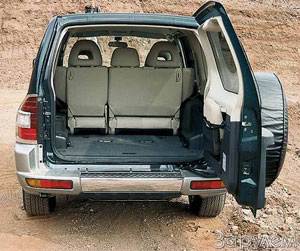 In a driver’s place, not only spacious, comfortable, well distributing loads, the seat bribes. As granted you perceive the excellent range of adjustments (electrical or mechanical, depending on the configuration). And what is the chubby steering wheel that lies in the hands. I remember that in the previous Pajero the driver did not feel so freely. In the middle of the instrument panel, liquid
In a driver’s place, not only spacious, comfortable, well distributing loads, the seat bribes. As granted you perceive the excellent range of adjustments (electrical or mechanical, depending on the configuration). And what is the chubby steering wheel that lies in the hands. I remember that in the previous Pajero the driver did not feel so freely. In the middle of the instrument panel, liquid the crystalline screen of the display with the readings of the route computer, data on the stereo system mode, external temperature, etc. To the right of the driver two levers - gearboxes and transmission control. Both became shorter, despite the fact that the ranges of their movements, both for a mechanical and automatic boxes, are optimized.
Want to be a passenger? In the back seat - the same scope, enough space for the legs and head. Even in a short -term version, you are located completely freely. One serious but: the seat pillow is clearly low - it is inconvenient and does not have a long journey.
In the trunk of a long -drawn Pajero, a third row of seats is found. They look somehow in the threshold, although two head restraints hidden in the back door should hint at full-fledged passenger places. If you use the trunk for its intended purpose, the seats are easily removed, forming a single whole with the floor of the cargo compartment (by the way, very capacious). In a short Pajo, the trunk is much more modest, but still more spacious than the previous version.
On the roads ...
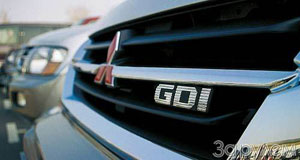
Most of all I want to try, of course, the most powerful gasoline version of a five -door Pajero
The motor immediately captivates with an excellent point in the characteristic. Touching - practically at a idle speed. With 1000 rpm is already even, without shocks and jerks, confident acceleration. And so on all programs up to 5000-5500 rpm. The character of the engine is so balanced that on the highway, and in the city you go around the V and IV programs - the rest are needed only when touched from the place and on the winding mountain surgery. With an energetic driving manner, the motor may even seem spineless - it does not have bright, sharp pickups revered by excessively temperamental drivers. Nevertheless, the new GDI six is \u200b\u200bgood. Even a long-played pajero accelerates without problems on an autobahn to 160-180 km/h, and on a three-door car speedometer arrow, playfully fits on a two hundred hundred
kilometer mark.
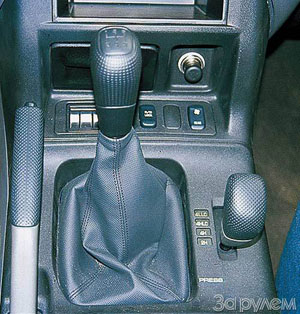 The speed capabilities of diesel is clearly more modest. Already by 160 km/h you feel a decrease in the speed of acceleration - it becomes obvious that the limit is somewhere close. The nature of the diesel engine is partially dictated by turbocharging. Until 2000 rpm, he with a lazy one responds to the movements of the accelerator pedal, then suddenly shows a remarkable temperament, and calms down by 4500 rpm again. All this makes the car alive, mobile, you just need to switch the gears more often.
The speed capabilities of diesel is clearly more modest. Already by 160 km/h you feel a decrease in the speed of acceleration - it becomes obvious that the limit is somewhere close. The nature of the diesel engine is partially dictated by turbocharging. Until 2000 rpm, he with a lazy one responds to the movements of the accelerator pedal, then suddenly shows a remarkable temperament, and calms down by 4500 rpm again. All this makes the car alive, mobile, you just need to switch the gears more often. The new Pajero liked the brakes. The pedal has practically no free stroke, and slowing control is carried out by a change in the closing force on the pedal. Everything is so understandable that there were never a multi -kilometer route for braking.
Not bad Pajero III and comfort. The leader here is long -drawn, with a gasoline engine. On the asphalt, his suspension perfectly works out all small irregularities and gentle waves. It feels like this is almost a passenger car, which, by the way, can not be said about the all -terrain vehicles of Mitsubishi of previous generations. Compared to a gasoline version, diesel is clearly tougher. He reacts more energetically to unevenness, more actively taps with tires on the seams and joints. This is a fee for stiffer diesel springs. About a short Pajor conversation is special. He literally encourages the riders with the transfer of small irregularities to the steering wheel and the body of the car, and waves are much more noticeable in it. This is a true all -around, in his suspension, it seems that not only springs, but also shock absorbers are tightened.
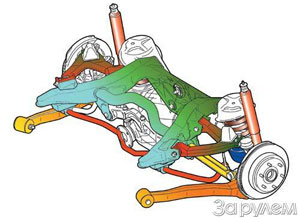 The new rear suspension not only improved the smoothness of the move, it fundamentally changed controllability. The previous Pajero was characterized by large rolls, smeared, fuzzy reactions - very characteristic features of many large all -terrain vehicles. Now the car has become different, it is captivated by the composure and accuracy of the responses to the actions of the driver. But there are modes in which you perceive the reactions of the machine even as excessively cars. This is especially the five -door gasoline version. At the speeds of 100-120 km/h Pajero too harsh, which makes the steering wheel very carefully control, and this is very inconvenient in restructuring and in gentle turns. By the way, neither diesel nor short -shot is excessive sharpness of reactions.
The new rear suspension not only improved the smoothness of the move, it fundamentally changed controllability. The previous Pajero was characterized by large rolls, smeared, fuzzy reactions - very characteristic features of many large all -terrain vehicles. Now the car has become different, it is captivated by the composure and accuracy of the responses to the actions of the driver. But there are modes in which you perceive the reactions of the machine even as excessively cars. This is especially the five -door gasoline version. At the speeds of 100-120 km/h Pajero too harsh, which makes the steering wheel very carefully control, and this is very inconvenient in restructuring and in gentle turns. By the way, neither diesel nor short -shot is excessive sharpness of reactions. And one more. Unexpected vibrations were surprised, and it was on long -drawn cars. As soon as the speedometer arrow is selected to 100 km/h, an unpleasant transmission rumble appears, developing into vibration. It is enough to press the clutch pedal, and the noise disappears. All this lasts up to 120 km/h. That it was a mystery, but the short -term version of such reboses did not throw up. Strange, for the rest of Pajero turned out to be very comfortable.
... and without them
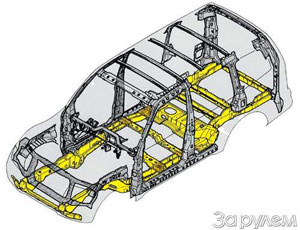 Real dirt did not have a chance to try. Our Pajero worked on mountain Spanish lanes and a special off -road highway, demonstrating mainly geometric cross and maneuverability. Both of the new car at the level. But something else revealed. He liked on the plain, Diesel disappointed on mountain serpentines. Its overhead character did not allow accurately dosing the torque on the drive wheels, which naturally required the early inclusion of a demultipliter. The gasoline engine, on the contrary, pleased with excellent traction, allowing it to climb into the second gear where the diesel was categorically not even at the first.
Real dirt did not have a chance to try. Our Pajero worked on mountain Spanish lanes and a special off -road highway, demonstrating mainly geometric cross and maneuverability. Both of the new car at the level. But something else revealed. He liked on the plain, Diesel disappointed on mountain serpentines. Its overhead character did not allow accurately dosing the torque on the drive wheels, which naturally required the early inclusion of a demultipliter. The gasoline engine, on the contrary, pleased with excellent traction, allowing it to climb into the second gear where the diesel was categorically not even at the first. A hard suspension of a short -term version on the off -road to vibrations on the steering wheel added a fair shake on bumps. So in the field, the most comfortable again turned out to be a five -door gasoline Pajero. Captivity has revealed another drawback: the lever that controls the transmission capabilities does not really inform the driver about the inclusion of a particular regime. In the heat of the fight against the crossed terrain, problems arose with the clarity of inclusions.
Body power schemes. The frames, as such, are no more!
SUMMARY
Of course, Mitsubishi Pajero III surpasses his predecessors. It is not only more economical and environmentally friendly, but also better adapted to the current requirements. Its assets have comfort, capacity, salon transformation, the best ergonomics and excellent sled qualities.
Well, what about the notes marked? You can come to terms with something, get used to something, and especially unpleasant, let's hope, the creators of the car will correct. Pajero III has already appeared in the interior of the official dealers of Mitsubishi Motors. The cost of this all -terrain vehicle ranges from $ 47,000 to 68,000, depending on the configuration.
Sergey Voskresensky
Photo by Sergey Voskresensky and Mitsubishi company
Source: The magazine "Driving"
Mitsubishi Pajero (Montero, Shogun) LWB 2000 - 2003
Mitsubishi Pajero (Montero, Shogun) LWB 2000 - 2003
Mitsubishi Pajero Faults 5 doors: Detailed information| Pajero (Montero, Shogun) LWB 2000 - 2003 | |
|---|---|
| Engine |  |
| Transmission |  |
| Control system and suspension |  |
| Brake system |  |
| Air heating and air conditioning |  |
| Launch and charging system |  |
| Electric components and so on |  |
| Corrosion body stability |

